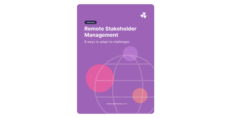How to Create a Stakeholder Communications Plan

Stakeholder communications make up a significant part of any stakeholder engagement, consultation, or stakeholder relationship management process.
You may even find that a stakeholder engagement plan on its own doesn’t go into enough detail on your communications, and you may need to expand on your stakeholder communication planning and strategy in a separate document.
In other words, you might need to create a stakeholder communications plan.
This short guide covers what you need to know about stakeholder communications plans, why you might like to create one, and how to create your own plan.
What is a Stakeholder Communications Plan?
A stakeholder communications plan is a strategic document that how an organization will communicate with stakeholders*, covering objectives, key messages, channels, tactics, and who’s involved.
*Remember — stakeholders are the people, groups, and organizations that are impacted by, have an influence on, or an interest in your project, policy, or work.
Stakeholder Communication Plans vs Stakeholder Engagement Plans
A stakeholder communications plan is not the same as a stakeholder engagement plan, although there may be some similarities between the documents.
An engagement plan’s main goal is to outline the engagement approach, which may include communication alongside other activities and tactics to manage and engage with stakeholders.
A stakeholder communications plan can have a range of different goals (brand awareness, information sharing, crisis management, building relationships, etc.) and any tactics inside the plan will be specifically focused on communicating with stakeholders.
3 Reasons to Create a Stakeholder Communications Plan

Get Clear on Messaging
Your stakeholder engagement plan likely won’t go into much detail on things like key messages and communication channels. In a stakeholder communication plan, you’ll have the space and structure needed to plan these out and go deeper on specific aspects of your communications.
Get More Specific
Your stakeholder engagement plan may cover an overarching strategy, but you might need to create a stakeholder communication plan (or several) for targeting specific stakeholder groups you need to engage with.
Get Aligned
A stakeholder communication plan can be a useful tool for coordinating your efforts and building alignment with other departments, such as your marketing, communications, and PR teams. But it can also help you get other people involved in your communications (and buy into your plans), such as organization leaders that will act as your spokesperson.
How to Create a Stakeholder Communications Plan

A stakeholder communication plan should include your goals or objectives, target audience, channels, strategies, allocation of responsibilities, timelines, and how you plan to monitor and evaluate your communications.
Step 1: Analyze the Situation
Before you can plan your communications, you need to analyze the current situation by conducting an audit of your existing channels and communications. Your analysis may touch on:
- A list of existing communications and campaigns
- Brand guidelines
- Analytics showing your audience/reach via existing platforms
- Audience perceptions of your brand
- What your competitors or similar brands are doing
- SWOT analysis
- Best practices and benchmarks
- Recommendations
Step 2: Define Your Goals
The next step in your stakeholder communications plan is to clearly define your goals or desired outcomes. Example goals for your stakeholder communications include:
- Ensure that all identified stakeholders are aware of the project/issues
- Influence stakeholder attitudes so that a higher percentage feel positively towards the project
- Encourage stakeholders to take action and participate in surveys and other engagement opportunities
It’s a good idea to use the SMART goals framework to help you define your objectives more clearly than the above generic examples. And ensure each goal in your plan aligns with your stakeholder engagement plan and broader organizational strategies.
Step 3: Describe Your Audience
In your plan, outline the audience you plan to target with your communications. This may include all your stakeholders but it’s usually better to target only a subset of stakeholders so that you can tailor your communications. This means you may need to create multiple stakeholder communications plans so that you can target different groups.
Use the insights from your stakeholder engagement plan and stakeholder analysis to describe your target audience. You may like to lay out the information in a simple stakeholder persona (check out the example in our blog on stakeholder diagrams).
Step 4: Get Tactical
Now that you’ve laid some strategic foundations for your communications, you can start to outline your tactics. Most communications plans will cover key messages. These are a list of 5-10 short statements that summarize what you want people to know about your project or consultation, and that you will repeat throughout the campaign.
It’s also common to list out your channels. In other words, the different platforms or communication methods you can use and how you plan to use them. Common channels include:
- Social media platforms
- Website
- News/press releases
- SMS
- Webinars
- Events
- Individual meetings
- Group meetings
- Face-to-face conversations
- Phone calls
Note that each channel has different pros, cons, and use cases, depending on who you need to reach, the content of the message, and what your audience expects.
Step 5: Assign Roles & Responsibilities
Stakeholder communications is rarely a one-person job. In your communications plan, you should outline who is responsible for what roles, such as:
- Company spokesperson/representative
- Public relations
- Media relations
- Crisis response
- Event planner
- Online community manager
- Brand identity
Include a brief description of the responsibilities and expectations associated with each role and ensure each person listed in the plan understands how they will be involved.
Step 6: Map Your Timeline
It’s likely that you’ll need to schedule your communications and messages in line with your stakeholder engagement activities and your project milestones. In your plan, map out a timeline of what you’ll communicate and when. You may also like to note down how often you plan to communicate via each channel. For example, you might send a monthly email and schedule 2-3 social media posts each week to keep your stakeholders in the loop.
Step 7: Outline Monitoring & Evaluation
Finally, your plan should cover how you’ll monitor and track your stakeholder communications so that you’ll know if you’re successful (tying these back to your original goals). For instance, you could schedule a quarterly check-in to review your analytics, stakeholder feedback, and KPIs. This will help you identify what strategies are working for continual improvement — and it can be a good opportunity to update your stakeholder communication plan if the situation has changed.
Quick Tips for Stakeholder Communication

Before we wrap up, we’ve got a few extra tips to help with planning and executing on your stakeholder communications:
Track Your Communication
Always keep track of the communications you send to specific stakeholders, and any responses you receive back. The best way to do this is with a stakeholder engagement tool like Simply Stakeholders — our email integration feature makes communication tracking quick and easy!
Analyze Your Stakeholder Responses
Each response from stakeholders is valuable data that can help you learn what your stakeholders really think about your project, work, or consultation. Objectively analyzing text-based responses can be tricky, though. Fortunately, a sentiment analysis tool like the one built into Simply Stakeholders can allow you to quickly (automatically!) analyze emails responses and comments using AI to understand the issues mentioned and how your stakeholders really feel.
Report On Your Communications
Be prepared to demonstrate the hard work you’ve been doing to communicate with stakeholders! Not only so that you can show your peers what you’ve been working on, but also so that you can demonstrate to stakeholders (and if required, regulators) how you’ve been actively informing and engaging them. Once again, relationship management software like Simply Stakeholders can help you quickly generate reports on stakeholders, showing who you’ve engaged with and how they’re responding to your communications.
Share Your Plan
Finally, once you’ve created your stakeholder communications plan, don’t forget to share it with others who may need to be involved in the process, coordinate their efforts with yours, or provide you with feedback/approvals. This includes your leadership team, communications professionals, marketers, project managers, external consultants, and more.
Learn More
Want to learn more about stakeholder communications, strategy, or planning? Check out our previous posts, including:






























